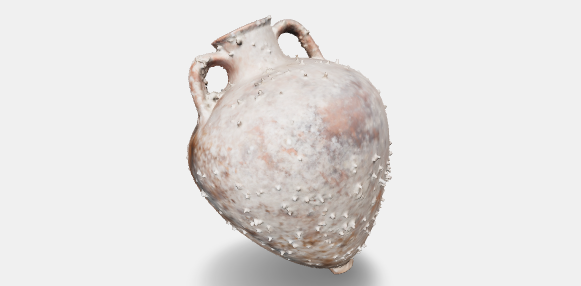Corcyraean or type B Corinthian amphora. Slightly everted rim, cylindrical neck. Oblique handles with thickened ribbon. Ovoid body. Foot with short, flattened tip.
The Corinthian amphorae were introduced to the Mediterranean in the last quarter of the VI century B.C. and their production lasted for the whole Classical age. It is a typical transport amphora for which various centres of production were identified in Corinth, Corfu and Sybaris.
In his famous classification of Corynthian amphorae, Koehler (1978, 1981, 1992) distinguished two different types of the B Corynthian amphora:
– the most ancient one, dating from the VI to the beginning of the V century B.C., characterised by a thickened rim with an almond-shaped section, a “turnip” shape, a short and a blunt foot.
– the most recent one, dating from the V to the III century B.C, characterized by a thickened rim with a nearly triangular section, a spherical or ovoid body and a small conical tip.
The amphora presents an epilithic (superficial) colonisation caused by Thoracica crustaceous (barnacles) and encrusting red algae, visible as a whiteish coat on the terracotta’s surface. The degradation caused by these organisms is visible as a light damage on the submerged surfaces, as the structure that adheres to the substrate affects only the outer surface of the material.

Koehler 1978
Koehler 1981, pp. 449-458
Koehler 1992, pp. 265-283
REFERENCES
Koehler C.G. 1978, Corinthian A and B Transport Amphoras, Ph.D. Dissertation, Princeton University.
Koehler C. G. 1981, Corinthian developments in the study of trade in the fifth century, Hesperia, Vol. 50, pp. 449–458.
Koehler C. G. 1992, A Brief Typology and Chronology of Corinthian Transport Amphoras. In Greek Am-phoras, V.I. Kats and S.Iu. Monakhov (eds.), Saratov, pp. 265-283.



